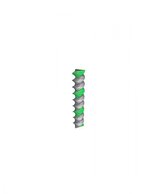OOPs and My unconventional method of cutting Mutistart Threads
Only correction I can give is it would be 0, 120, 240, not 270 on the spacing. (Although it make a unique thread!)
I'm a bit under the weather at the moment with an infection of some kind!!!!
Should read:-
"The starts of the 3 threads will start at positions that are a third of 360 degrees apart, ie 0 degrees 120 degrees and 240 degrees"
I realized it was wrong after a couple of days but, by then, the ability to edit my post had past!
Easier if making your own thread as you can choose a thread evenly divided by three, so when you set the compound you can advance an even number for each thread, and not have to 'split hairs'!
As far as advancing the compound is concerned I have discovered this method works on a nice tight decent lathe but on my ole, clapped out, Sieg Chinese lathe (Never really great in the first place) this resulted in 3 threads that were not really starting 120 degrees apart and not consistent in shape either. This resulted in male and female threads that didn't quite like starting in some orientations. As I used the taps, I had produced, to make their corresponding Dies, errors just unacceptably increased.
Thoughts around this problem showed that plus and minus ½ thou" of horizontal, error due to sloppy slides etc., resulted in a 4 degree error in starting the individual threads. So I looked for a way of reducing this and this is the way I do it now that gives me consistent results!
I tie everything down. I tighten up the end Gib screw on the compound slide and don't touch it till I've finished all three threads
I get much better results by using a collet chuck which I use with all its fixing screws present for triple threads:-
1. Lock the compound side solid with its end Gib screw.
2. Set the cut depth with the cross slide. (5 thou first cuts to 15 thou then 2 then 1 for the three final cuts)
3. Lock the cross slide with its last gib screw.
4. Cut the thread
5. Unlock the cross slide gib screw and withdraw the tool.
6. Reverse the motor and go back to the start.
7. Repeat 2 to 6 above
8. Cut to the correct depth of thread.
9. Repeat the last cut 5 times to allow for spring of the tool.
10. Undo the fixing nuts and remove collet chuck with the job still tight in the collet.
11. Move the chuck around to the next position of the 3 holes.
12. Repeat 2 to 7 for the next thread
13. Repeat 8 and 9 for the 3rd thread.
Cutting 2 start and 4 start threads becomes a bit more difficult but after some thought I arrived at this method that, maybe surprisingly, does work:-
1. Remove 2 of the 3 fixing studs from the collet chuck and set them aside.
3. Loctite the remaining stud into the collet chuck.
2. Using the collet chuck's one remaining stud insert it into one of the 4 fixing holes in the headstock back chuck mounting plate. Rotating the chuck as far as it will go clockwise to take up any slack in position before tightening its fixing nut.
3. With a Sharpy mark this as number one and the others likewise to 4
4. Proceed to cut the multi threads 2 or 4 as 1 to 13 above using every other hole for a 2 start and all holes for a four start.
I use a flat topped HS tool ground to a front angle of 60 degrees with clearance angles of about 8 degrees. (i.e No top rake or side rake)
With small cuts, as suggested above, the resulting threads are very good with minimal jamming, judder, although, with Drill Rod(For taps), a small amount of bur removal, with a Swiss file, on the crests of the threads is needed.
Regards,
John

